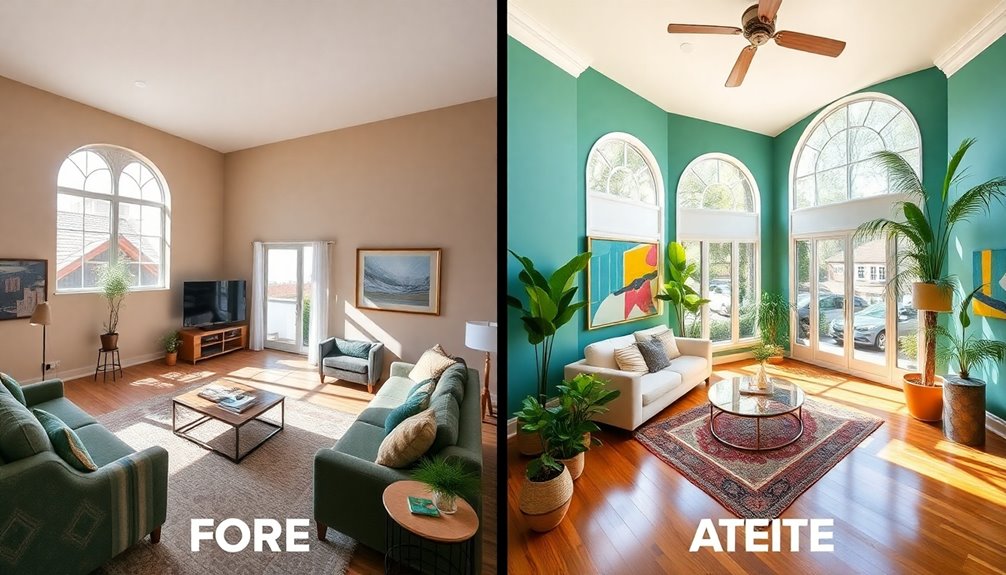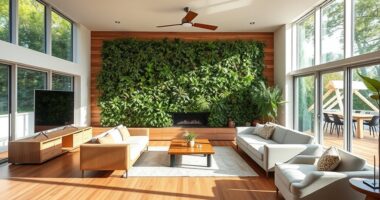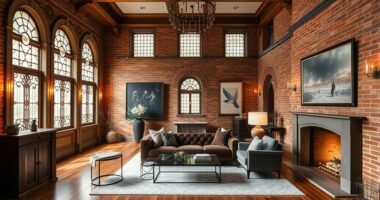Transforming your home from dull to dazzling starts with identifying key areas to remodel, like kitchens, bathrooms, and outdoor spaces. Prioritizing these upgrades enhances your property's value and boosts your well-being. You can either tackle these projects yourself or hire professionals who guarantee quality. Smart designs and sustainable materials can further elevate your space while also being budget-friendly. Embracing current trends like open layouts and earthy tones will create inviting atmospheres. Ready to unleash your home's full potential? You'll discover even more strategies and ideas that can help you achieve stunning transformations.
Key Takeaways
- Upgrading kitchen appliances and layouts can significantly enhance efficiency and aesthetic appeal, transforming a dull space into a vibrant gathering area.
- Incorporating biophilic design elements, like natural materials and greenery, elevates home aesthetics while improving overall well-being and tranquility.
- Outdoor living enhancements, such as patios and fire pits, create inviting spaces for social gatherings, boosting both beauty and usability.
- Smart home technology integration offers modern conveniences, making spaces more functional while adding a touch of sophistication to interiors.
- Strategic use of colors and textures, such as earthy tones and warm textiles, can instantly refresh and elevate the ambiance of any room.
Importance of Home Transformation
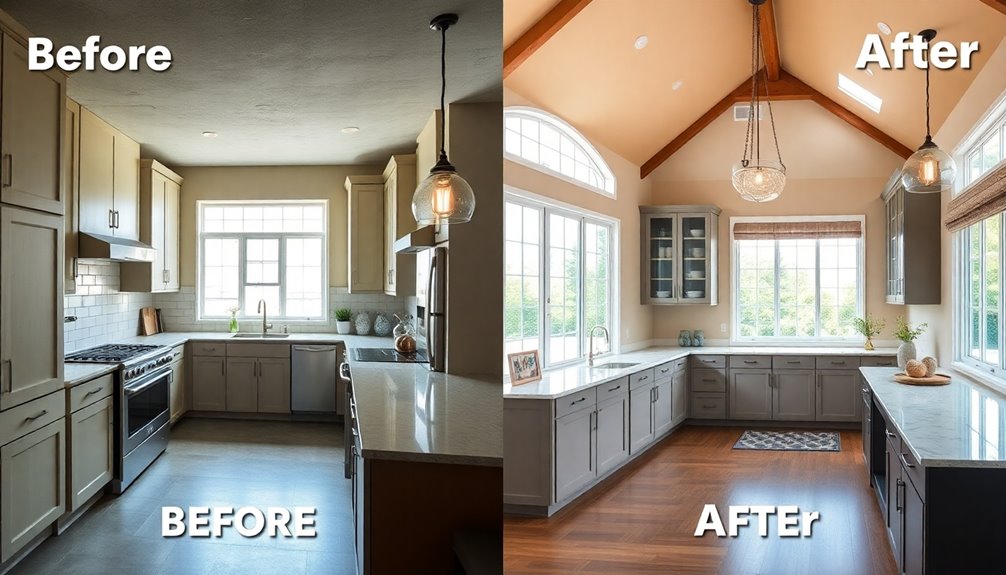
Home transformation isn't just about aesthetics; it plays an essential role in enhancing your property's value and livability. When you invest in home improvement, you're not just sprucing up your space; you're making a smart financial decision. Well-executed renovations can yield a return on investment of 70% to 80% or more, particularly in key areas like kitchens and bathrooms. These transformations can greatly increase buyer interest and lead to higher sale prices.
Moreover, transforming your home improves functionality and allows you to tailor your environment to reflect your personal style. Aesthetically pleasing spaces contribute to your overall well-being, boosting your mood and reducing stress. You'll find that a personalized and functional environment fosters comfort and happiness, encouraging relaxation and social interaction. Incorporating elements like open floor plans can further enhance the flow and usability of your home. Additionally, integrating energy-efficient water systems can enhance your bathroom's sustainability while reducing utility costs. Understanding local building codes can also ensure that your renovations are safe and compliant, adding to the overall value of your investment.
Understanding the importance of home transformation goes beyond immediate benefits. It's about creating a space that not only meets your needs but also enhances your lifestyle. Additionally, state-specific benefits can provide further financial advantages when planning your home improvements.
Whether you're planning a major overhaul or simple updates, remember that every improvement counts. Your home is a reflection of you, so embrace the opportunity to create a sanctuary that resonates with your tastes and lifestyle.
Key Areas for Transformation

When it comes to transforming your space, focusing on key areas can make a considerable impact on both functionality and style. One of the most effective ways to transform your space is by utilizing facelift formula techniques, such as decluttering, repurposing, and incorporating pops of color. By decluttering and organizing your space, you can instantly improve its functionality and create a more polished look. Repurposing old furniture or décor items can also breathe new life into your space, giving it a fresh and unique feel. Adding pops of color through accent walls, throw pillows, or artwork can inject personality and style into any room. By focusing on these key areas and utilizing facelift formula techniques, you can create a space that feels completely revitalized.
The kitchen often takes center stage in home renovation projects. Upgrading to modern appliances and rethinking the layout can enhance both the efficiency and the visual appeal of this crucial area.
Next, consider your living room. Rearranging furniture and updating decor not only creates a more comfortable environment but also reflects your personal style. Adding ambient lighting can greatly change the atmosphere, making it cozier for gatherings or peaceful evenings.
Don't overlook the bathrooms. Updating fixtures, tiles, and lighting can create a luxurious feel while boosting your property's value. Incorporating natural elements such as wood and stone can further enhance the aesthetic appeal and ambiance of your bathroom. Consider adding vintage fixtures to capture the essence of farmhouse style.
Bedrooms also deserve attention; think about incorporating storage solutions and soothing color schemes to promote relaxation.
Lastly, outdoor spaces can be revitalized through landscaping and patio improvements, expanding your usable living areas and enhancing curb appeal.
Budgeting for Remodeling
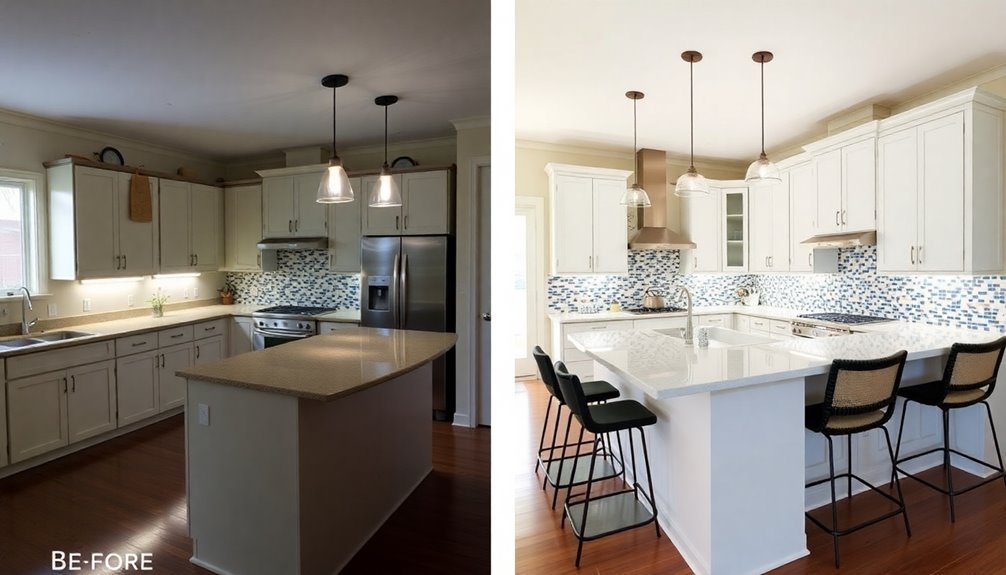
Before diving into a remodeling project, it's crucial to establish a realistic budget that reflects your financial situation. Start by researching average costs for materials and labor to create a detailed budget breakdown. This step guarantees better financial management and allows you to prioritize projects effectively. Additionally, understanding your credit score can help you gauge your financing options more accurately. Consider including a contingency fund of 15-20% for unexpected expenses. This way, you won't face financial strain when surprises arise. As you work through your remodeling journey, track your spending closely to stick to your budget and prevent overspending. It's also wise to assess market trends to avoid overestimating your budget. Implementing the 50/30/20 rule can also help you allocate your finances more efficiently.
Here are some ways to visualize your budget:
- A sleek kitchen upgrade with modern appliances
- A cozy, updated bathroom retreat
- A spacious outdoor living area for entertaining
When budgeting for remodeling, remember to prioritize projects based on necessity and impact. Address critical updates first, as they maximize the value of your investment. Additionally, consider consulting a financial advisor to explore potential financing options that can help manage costs more effectively. Utilizing cashback apps can also provide extra savings on materials.
If larger renovation costs challenge your cash flow, consider financing options like home equity loans or personal loans. By taking these steps, you'll set yourself up for a successful remodeling experience while staying financially sound.
DIY vs. Professional Help
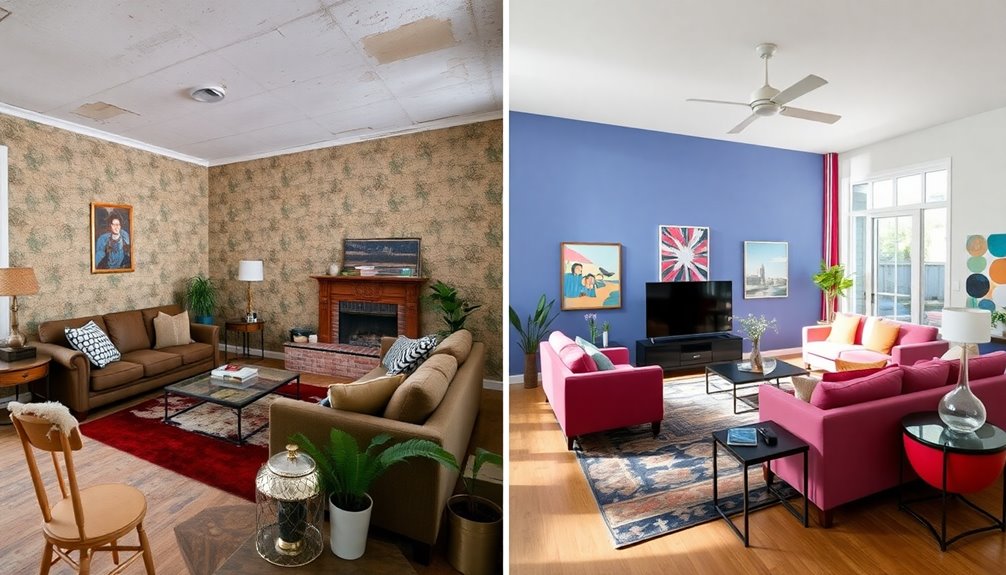
Deciding between DIY renovations and hiring professionals can greatly impact your remodeling project. While you can save 20-30% on labor costs by taking the DIY route, it requires a major investment of time and skill. Assess your capabilities realistically; only 30% of DIY enthusiasts feel confident handling major renovations without professional help.
Here's a quick comparison to reflect upon:
| DIY Approach | Professional Help |
|---|---|
| Cost-effective | Higher initial costs |
| Time-consuming | Faster project completion |
| Requires skill & effort | Licensed expertise needed |
| Great for small tasks | Ideal for complex work |
| Personal satisfaction | Quality assurance |
Balancing DIY projects with professional help can be an effective strategy. You can tackle manageable tasks yourself while relying on experts for plumbing or electrical work, which require licensed knowledge to guarantee safety and compliance. If you have time to plan and manage your project, a mix of both can lead to stunning transformations without overwhelming you. Remember, utilizing a contractor can speed up the remodeling process considerably, which is vital for time-sensitive renovations. Additionally, ensuring that your living space remains organized through efficient storage strategies can enhance the overall aesthetic and functionality of your newly remodeled areas.
Current Trends in Remodeling
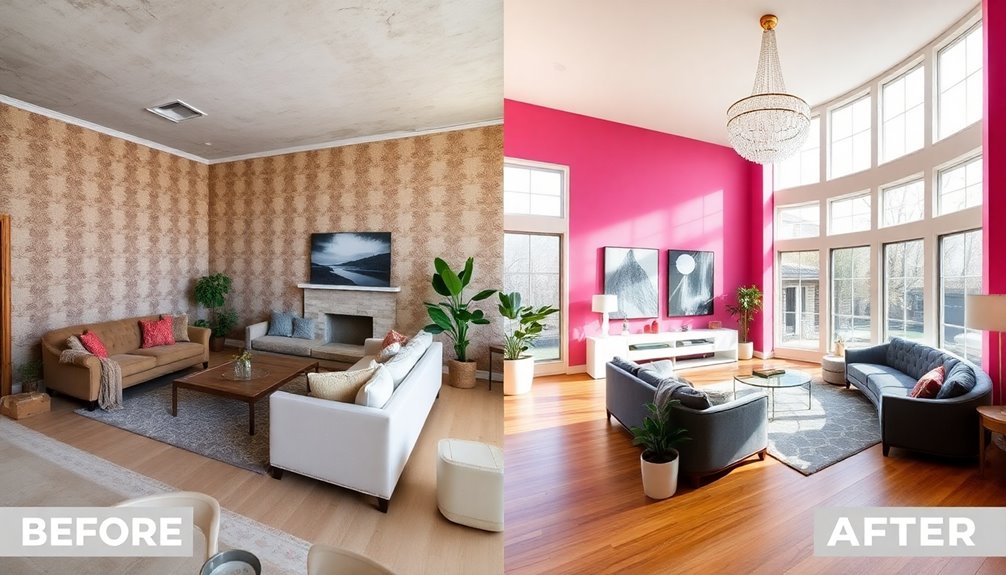
Balancing DIY projects with professional help sets the stage for understanding current trends in remodeling. Homeowners today are embracing designs that reflect both personal style and functionality.
Here are some key trends you'll want to evaluate when diving into your remodeling project:
- Minimalist designs that create an uncluttered, serene atmosphere, making spaces feel open and inviting.
- Earthy tones and natural materials like wood and stone, providing a calming environment while promoting sustainability. Additionally, integrating smart home technology can enhance the functionality of these design elements. Incorporating textiles like burlap and linen can further add warmth and texture to your space. The use of Indonesian decor masks can also elevate the aesthetic appeal, adding cultural significance to the design.
- Biophilic design elements that enhance natural light, connecting indoor spaces with the outdoors and boosting overall well-being.
Open-concept layouts continue to dominate, enhancing the flow of living areas essential for modern lifestyles.
You'll also find that smart home technology is becoming a must-have in renovations, offering energy-efficient solutions that elevate convenience and security. Additionally, incorporating aesthetic hooks and wall organization can maximize space and add a stylish touch to your home.
Creative Space Transformations
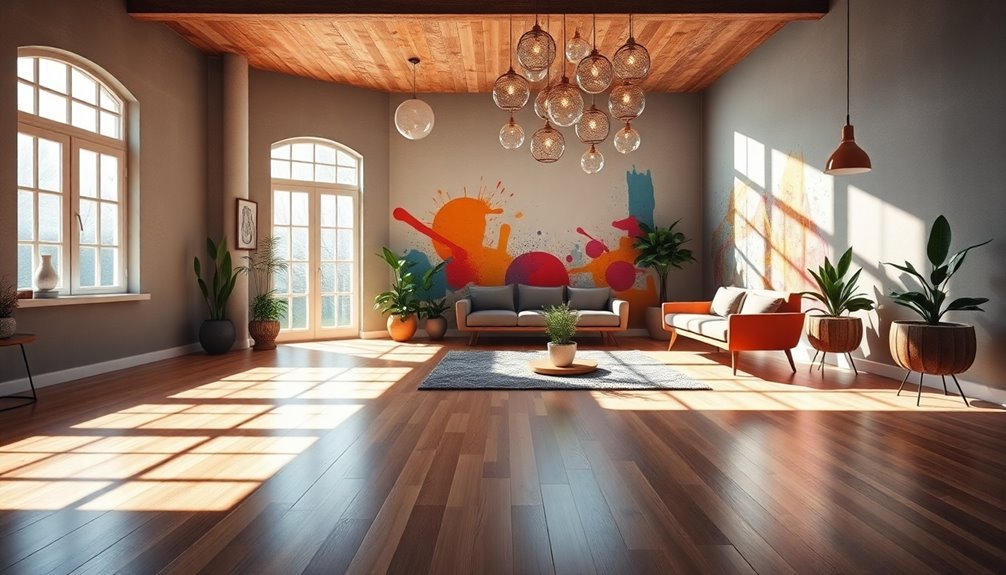
When you're short on space, multifunctional furniture can be a game-changer, maximizing both style and comfort. Plus, enhancing your outdoor areas can turn them into inviting extensions of your living space, perfect for relaxation or entertaining guests. Additionally, implementing vertical storage solutions can help free up floor space, making your home feel more open and organized. By incorporating natural elements into your decor, you can further promote tranquility and a serene atmosphere throughout your home. Furthermore, utilizing self-watering planters can simplify your gardening efforts, ensuring your plants thrive with minimal maintenance. Adding vibrant flowers like daisies can also enhance your outdoor spaces, attracting pollinators and creating a lively environment. Let's explore how these creative transformations can make a real difference in your home.
Multifunctional Furniture Solutions
Transforming your living space into a multifunctional haven can considerably enhance both its practicality and style. By incorporating multifunctional furniture, you can maximize storage and create a more organized and inviting atmosphere.
Imagine the possibilities:
- A chic sofa bed that effortlessly converts into a cozy sleeping area for guests.
- An elegant ottoman with hidden compartments, perfect for stashing away blankets and magazines.
- A sleek, extendable dining table that fits snugly in your kitchen but expands for larger gatherings.
These creative solutions not only save space but also elevate your home's aesthetic appeal. Modern farmhouse design emphasizes simplicity and functionality, making these pieces even more appealing. Additionally, consider how lighting design can enhance the ambiance of multifunctional areas, making them more inviting.
Built-in furniture, like benches with storage or wall-mounted desks, seamlessly blends into your décor while offering practical functionality. You'll find that every piece serves multiple purposes, making your living area versatile enough for various activities—from relaxing with a book to entertaining friends.
Incorporating natural materials like wood not only enhances the visual appeal of your multifunctional furniture but also aligns with the essence of farmhouse design.
With multifunctional furniture, you're ready to be inspired and transform your home into a stylish, clutter-free sanctuary that meets all your needs.
Embrace this innovative approach and watch your space flourish into something truly dazzling!
Outdoor Living Enhancements
A well-designed outdoor space can substantially enhance your home's livability and aesthetic appeal. By transforming your yard into a functional extension of your home, you create inviting areas for relaxation, dining, and entertaining.
Consider adding patios to provide a solid foundation for outdoor furniture and gatherings. Outdoor kitchens are another fantastic addition, allowing you to cook and dine al fresco, making every meal feel like a special occasion.
Pair these features with cozy fire pits, and you've got the perfect recipe for memorable evenings under the stars. Landscaping plays an essential role in enhancing your outdoor area.
Utilize colorful plants and thoughtful arrangements to bring beauty and tranquility, creating a serene environment. Add elements like pergolas or awnings to provide shade, ensuring you can enjoy your outdoor space in any weather.
To elevate the ambiance further, implement mood lighting, such as string lights or lanterns, which transforms your space into a magical retreat for evening gatherings. Additionally, consider integrating energy-efficient systems to ensure your outdoor living area remains comfortable throughout the seasons.
With these outdoor living enhancements, your home will truly shine, offering a seamless blend of comfort and style.
Key Considerations for Basement Remodeling

When you're planning your basement remodel, moisture control should be at the top of your list. Without proper waterproofing and drainage solutions, you risk water damage that can undermine your hard work. Additionally, a functional layout is key to maximizing your space, so think about how you want to use the area and plan accordingly. Regular preventive maintenance can help ensure that your appliances remain in good working condition and avoid unexpected repairs in the future. Incorporating durable materials that withstand moisture can further protect your investment. Consider installing heat pumps for efficient climate control, as they can significantly reduce energy consumption while providing both heating and cooling capabilities.
Moisture Control Solutions
Moisture control is essential for ensuring a successful basement remodeling project. Without it, you risk mold growth, which can compromise indoor air quality and lead to health issues. To create a durable, welcoming space, consider implementing effective moisture control solutions.
- Install waterproofing systems like sump pumps and drainage channels to manage excess water.
- Use vapor barriers on walls and floors to reduce moisture infiltration, protecting your basement's structural integrity.
- Incorporate dehumidifiers to maintain humidity levels below 60%, discouraging mold and mildew.
Don't forget to regularly inspect your gutters and downspouts, ensuring they direct water away from your foundation. This simple maintenance step minimizes the risk of basement flooding, keeping your newly remodeled area dry and comfortable.
Functional Layout Planning
Planning a functional layout for your basement remodel involves evaluating how you want to use the space and ensuring it meets your lifestyle needs. Start with proper layout planning by determining if you prefer open areas for entertaining or defined rooms for privacy and specific functions.
Think about how you'll use the space together with family or friends. This versatility can considerably enhance your basement's value.
Don't forget about the essentials, like moisture control and insulation. Ensuring adequate moisture control through waterproofing will keep your basement dry and comfortable. Proper insulation is vital for maintaining a consistent temperature during colder months.
Lighting plays a considerable role in your basement's ambiance. Incorporating sufficient lighting, like recessed or pendant fixtures, can brighten darker areas and make the space more inviting.
Explore various functional uses for your basement, such as game rooms, home offices, or reading nooks. By considering all these aspects, you'll create a functional layout that boosts both usability and comfort, transforming your basement into a dazzling space tailored to your needs.
Frequently Asked Questions
How Long Does a Typical Remodel Project Take?
A typical remodel project usually takes anywhere from a few weeks to several months, depending on the scope and complexity.
For smaller renovations, like a bathroom remodel, you might wrap it up in 4 to 6 weeks.
Larger projects, such as a full kitchen overhaul, could take 2 to 3 months or more.
It's crucial to factor in planning, permits, and potential delays to get a clearer timeline for your specific project.
What Are Common Mistakes to Avoid During Remodeling?
When remodeling, avoid common mistakes that can derail your project.
Don't underestimate your budget—always include a contingency for unexpected expenses.
Skipping research on materials can lead to poor choices, so take your time.
Don't forget to communicate with contractors; clear expectations are essential.
Finally, avoid rushing decisions; think through your design and layout.
How Can I Maintain My Remodeled Space?
To keep your newly remodeled space sparkling and stylish, start with simple, smart strategies.
Schedule regular cleaning sessions to sweep away dust and debris. Use protective pads under furniture to prevent scratches and scuffs.
Stay on top of minor repairs, tackling them promptly to avoid bigger problems later.
Finally, showcase your space by selecting suitable decor that complements your design, ensuring your hard work continues to shine bright for years to come!
What Permits Are Needed for Home Renovations?
When you're planning home renovations, you'll need to check which permits are required.
Generally, you'll need permits for structural changes, electrical work, plumbing, or even major landscaping.
It's crucial to contact your local building department to understand specific regulations in your area.
They'll guide you through the process and help you avoid fines or issues down the line.
Always better to be safe than sorry!
How Can I Increase My Home's Value Through Remodeling?
To boost your home's value, focus on functional features and fabulous finishes.
Start with a kitchen facelift, updating appliances and countertops.
Bathrooms benefit from modern upgrades like sleek tiles and stylish fixtures.
Consider creating open spaces, enhancing flow and light.
Curb appeal matters too; paint the exterior and spruce up landscaping.
Finally, don't overlook energy efficiency; insulation and windows can save you money and attract buyers.
A well-planned remodel can greatly increase your home's worth!
